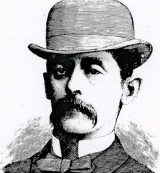Breaking the 400 barrier
Simon Wilde looks back at the first man to score more than 400 in an innings
Simon Wilde
23-Mar-2007
|
|

|
Tylecote was born on June 23, 1849, in Bedfordshire, and, like his three brothers, went to Clifton and Oxford. He arrived at Clifton College in April 1863 two terms after the school had been founded, and it wits here that as a 19-year-old he made his unprecedented score. He was in the XI every year -- five times in all -- a very rare feat. In 1868 he was captain. Apart from being a formidable scholar and cricketer, Tylecote was also a superb athlete who took many prizes, particularly with his sprinting. His great batting year was 1868. In first-team matches for the college Tylecote averaged over 70 (a very remarkable figure for the time) and scored the first two centuries in the school's history.
His great score was made in an internal match between Classical Side and Modern Side, played on three afternoons on the College Close from Saturday, May 23 to Tuesday, May 26. On each day play was from 2.45 to 5.30 p.m. There were no boundaries except the perimeter of the Close, a hit to which earned by convention four runs, though it can seldom have been achieved. Otherwise every run had to be run out.
The only detailed account of Tylecote's match seems to be in a contemporary issue of The Cliftonian, apparently written by E. N. P. Moor, who was playing for the Classicals. Classicals v Moderns was an annual fixture at Clifton, and one which the Classicals invariably won. (Modern Side was thought inferior to the Classical Side, where the traditional form of education was taught.)
Modern batted first and made 100. Only Cross (20) and the left-handed J. A. Bush (49) got into double figures. (Bush later enjoyed a long career with Gloucester-shire, being like Tylecote one of the leading wicketkeepers of the 1870s and 1880s. He was WG's best man.) Classicals were left about half an hour's batting on Saturday, in which time Tylecote lost his opening partner with the total on 6. At stumps Tylecote was 34 and W. C. F. Cross 'about a dozen'.
Play resumed on Monday afternoon and Tylecote began scoring very quickly. By the time Cross had been caught for 30 he 'had made his first hundred with a few to spare'. Bush now took off the gloves to bowl his slows and soon captured a wicket, though not that of Tylecote, who developed a fast-scoring partnership with Goodwyn. Goodwyn was dismissed for 52. Just before stumps Fox was caught at the wicket, off a lob from Bush, for 25. The total at stumps was 340 for 5 and Tylecote was on 199. During the afternoon he had added 165 to his score in two-and-a-half hours, exactly a run a minute.
|
|
When the chapel bell struck 5.30 it signalled an end to the day's play and to the match. The Classical first innings remained uncompleted; Tylecote, batting relentlessly on, was 404 not out. He had scored 205 runs in two-and-a-half hours that afternoon.
The Classical total of 630 for 9 lasted six hours, which is the time Tylecote batted. The match had to be given up as a draw: Classical could not declare -- such devices did not then exist and the only way to get Modern in again would have been to lose all their own wickets first.
There must have come a point when the size of both Classical's total (that was a world record too) and Tylecote's own score were of more interest than the result of the game. It has been said that the match was extended -- presumably into the third day -- to allow Tylecote an opportunity to continue.
How many chances, if any, Tylecote gave it is difficult to ascertain, but were he missed several times it is likely that The Cliftonian would have mentioned it. His scoring strokes were: one seven, five fives, 21 fours, 39 threes, 42 twos and 87 singles. Except for one shot of his own, "a magnificent hit far out of the ground" which brought him four, he had to run out every run of the innings.
Although he was obviously equipped with a wide range of attacking strokes, everyone who described his batting always commented on his steadiness in defence. At school he had the nickname of 'The Invincible'. His huge score had been the product of this strong technique, a steadfast concentration, and superb physical fitness.
Tylecote never became a prolific batsman in first-class cricket. He was reliable and could at times be punishing: he scored a chanceless 107 in two-and-a-half hours for the Gentlemen in 1883 and took 100 not out off the 1882 Australians. But for a long time -- too long perhaps -- other things took priority to cricket. When he did play there was the distraction of wicketkeeping, which he had begun to develop while at Oxford.
Tylecote's 404 had raised the gaze of batsmen to new horizons. There was one who did not need to look twice.
Notes
I. W. H. Knight, prompted by the general interest aroused in the subject in 1868, wrote a resume of previous double-centuries which went into the 1869 Wisden. It was the first article ever to appear in the Almanack. 2. Less extras, which totalled only five on this last afternoon.
I. W. H. Knight, prompted by the general interest aroused in the subject in 1868, wrote a resume of previous double-centuries which went into the 1869 Wisden. It was the first article ever to appear in the Almanack. 2. Less extras, which totalled only five on this last afternoon.
This article first appeared in the April 1982 edition of Wisden Cricket Monthly